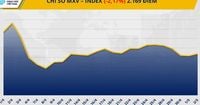On May 5, 2025, the price of gold experienced a significant surge, adjusting up by 100 baht at the market's opening. This sudden increase prompted many investors to panic and sell their holdings, resulting in a total rise of 800 baht throughout the day. By the end of the trading session, the buying price for gold bars reached 51,550 baht, while the selling price was set at 51,650 baht. For gold ornaments, the buying price was 50,619.24 baht, with a selling price of 52,450 baht.
This fluctuation in gold prices comes amid a backdrop of economic uncertainty, particularly concerning crude oil prices. According to data from MXV, crude oil has been in a state of decline for the second consecutive week, driven by various global uncertainties regarding supply. The Brent crude oil price closed at 61.29 USD per barrel, reflecting a drop of 6.85%. Meanwhile, WTI crude oil fell by 7.51%, dipping below the 60 USD per barrel mark before recovering slightly to close at 58.29 USD per barrel.
The downward pressure on oil prices has primarily stemmed from expectations that OPEC+ will continue to ramp up production in June 2025, following decisions made to increase output in May. This anticipation was compounded by reports on April 23 indicating that some OPEC+ member countries were already producing oil above their quotas, raising worries about excess supply in the market.
Market analysts noted that the situation was exacerbated by a series of negative macroeconomic indicators from the United States. These included a contraction in the labor market, a decline in consumer confidence, and the first drop in GDP for the first quarter of 2025 in three years. Concerns about the U.S. economy's trajectory have led to doubts regarding future oil demand.
Despite these challenges, investors remain cautiously optimistic about the potential for a new trade agreement between the United States and major trading partners, particularly China. This optimism has provided some support to the declining oil prices. Additionally, a decrease in U.S. crude oil reserves and reduced oil exports from Venezuela have also contributed to stabilizing oil prices.
Amid these fluctuations, the agricultural commodities market has not fared any better. The agricultural sector saw a significant downturn, with all seven major commodities closing in the red. Corn prices, for instance, recorded a third consecutive week of decline, falling approximately 3.4% to 184 USD per ton. Similarly, wheat prices dropped slightly by 0.37%, ending the week at 199 USD per ton.
The negative trends in agricultural prices reflect the impact of both demand and supply factors, as well as technical developments in the market. As the week closed, the agricultural sector was overwhelmed by adverse market conditions, highlighting the interconnectedness of these commodities with broader economic trends.
As the market continues to navigate these complex dynamics, both gold and crude oil prices remain under scrutiny. Investors are left to ponder the implications of economic indicators and OPEC+ decisions on future price movements. With global economic uncertainties looming, the coming weeks will be crucial in determining the direction of these key commodities.
In summary, the price of gold surged significantly on May 5, 2025, amid rising market tensions, while crude oil prices continued to decline due to economic concerns and OPEC+ production forecasts. The agricultural sector also faced challenges, reflecting broader economic trends that are likely to influence commodity prices in the near future.

